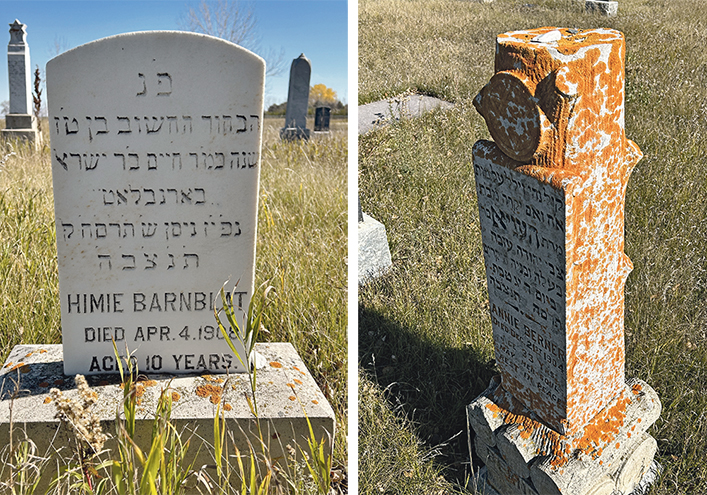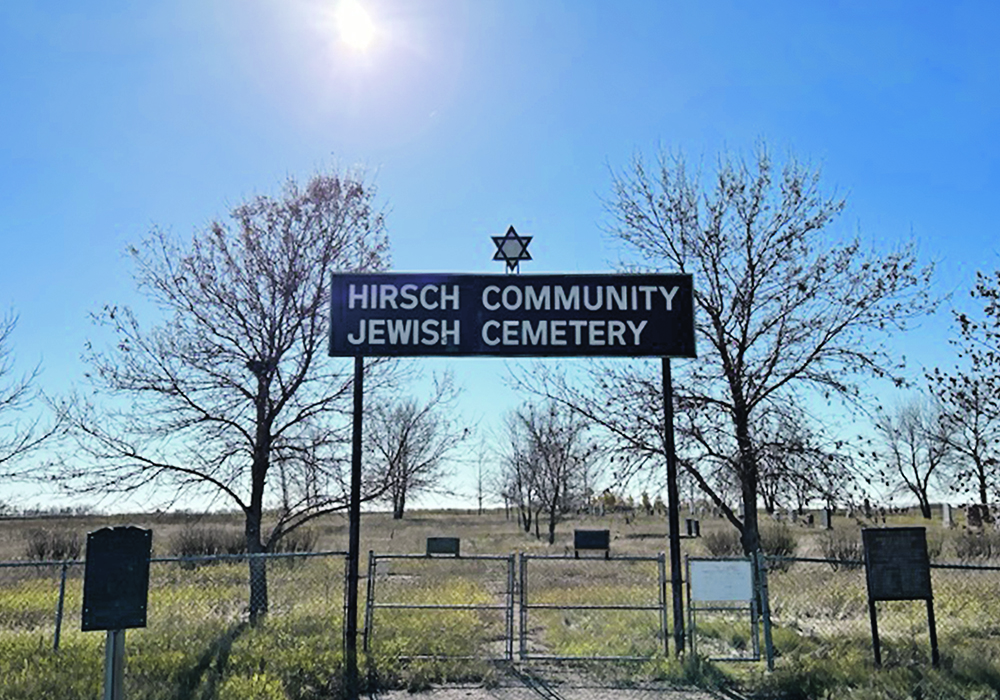HIRSCH, Sask. — With dusty, short, dryland grass growing between the plots, the Hirsch cemetery seems like any of hundreds across the Prairies in autumn. The ground crunches when you walk between the plots. The wind whispers but says no names.
The gravestones represent a collection of pioneers who lived in the early settlement days. The brief stone-carved stories are testament to the harsh conditions that hundreds of thousands of European immigrants faced as they tried to build a life free of persecution and exploitation.
- Himie Barnblat. Died Apr. 4, 1908. Aged 10 years.
- Annie Berner. Died Dec. 21, 1904. Aged 33 years. May Her Soul Rest in Peace.
- Unknown
In death the residents rest like those anywhere else in farm country, but the specific differences here are obvious.
Most of the grave markers contain Hebrew. Some are engraved only with Hebrew words.
Stars of David are on some stones. A menorah is carved into one.
Many of the gravestones have pebbles atop, a sign that people have visited to pay respects to the departed and signal their survival in memory.
This cemetery is one of the few pieces of evidence on the Prairies of a unique period in Jewish and Canadian history, when communities of Jewish farmers were established, broke and farmed the dryland soil and lived and died beneath the living skies of Saskatchewan, Manitoba and Alberta.
The Prairies were home to 31 Jewish farming colonies, founded with the assistance of Baron Maurice de Hirsch, a German-Jewish aristocrat. These colonies were established before most of the other waves of immigrants reached Canada. In those days there were British settlers, French settlers, Icelanders and Jews.
Baron de Hirsch wanted to give eastern European Jews the chance for a life without the persecution, prejudice and violence they had faced for centuries. Part of that abusive treatment often involved Jews being banned from owning farmland, so many of the Jews who ended up on the Prairies had little farming experience and had to learn fast.
The baron funded similar efforts in the United States, Australia and other immigration-friendly nations. Jews in the settler nations often faced the same anti-semitism they were familiar with elsewhere, but the difference was that these societies at least legally tried to be fair to religious and ethnic minorities. Many of the obstacles experienced in Europe were absent.
Hirsch and other colonies faced the same mixture of thriving and suffering that were common regardless of religion, race or language. Jewish farming communities matured, young people moved away to greater opportunities in the cities, farming consolidated, and the Jewishness of the areas faded and has been mostly forgotten by outsiders.
About 20 years ago I first visited this cemetery after learning about a unique period of Jewish farming history in Canada. I visited the Kleimans, two Jewish brothers who were still farming in the Hirsch area, and marvelled at the historic legacy for which they were some of the last representatives.
There are still farmers of Jewish descent on the Prairies, but you won’t find a lot of synagogues in rural Canada. The Jewish farming fact in Canada has become a footnote in accounts of early settlement.
Jewish farming still exists elsewhere, reborn in Israel with the new nation itself. Commercial farming exists in a manner that would be familiar to us, in individually operated family farms and by kibbutzes that are strikingly like Hutterite colonies. Desert conditions don’t lend themselves to easy farming, but as in Western Canada, Jews in Israel have found ways to eke a living out of the parched soil.

Some of Israel’s kibbutzes lie beside the Gaza Strip, where frightful violence erupted Oct. 7, hitting Jewish farming communities in a manner that recalled the pogroms of Eastern Europe, in which marauders sporadically laid waste to Jewish lives and communities.
That sort of horrifying farming history didn’t occur in Canada, and that’s something we can all be grateful for. I didn’t visit the Hirsch cemetery because of Oct. 7. I was merely passing by with my middle kid as we explored some other prairie history on the drive home to Winnipeg from Regina.
But on a day in which the airwaves were filled with accounts of tragedy and shock and death, this cemetery of Jewish graves seemed somehow uplifting.
Here people lived, struggled, farmed and died like any immigrants across the Prairies. They got a shot at creating a new life and they took it.
Canada, especially Western Canada in the winter, can seem like an incredibly harsh environment. But hunkering down to last out a winter is a lot better than hunkering down to avoid rockets, murderers and pogroms.
When we look at the past of this farming land, we often marvel at the fortitude of the people who settled here.
But as we have just witnessed, sometimes the brutality of the weather is nothing compared to the brutality of our fellow human beings, and given a choice, most of us would take our chance with this unforgiving environment.
















